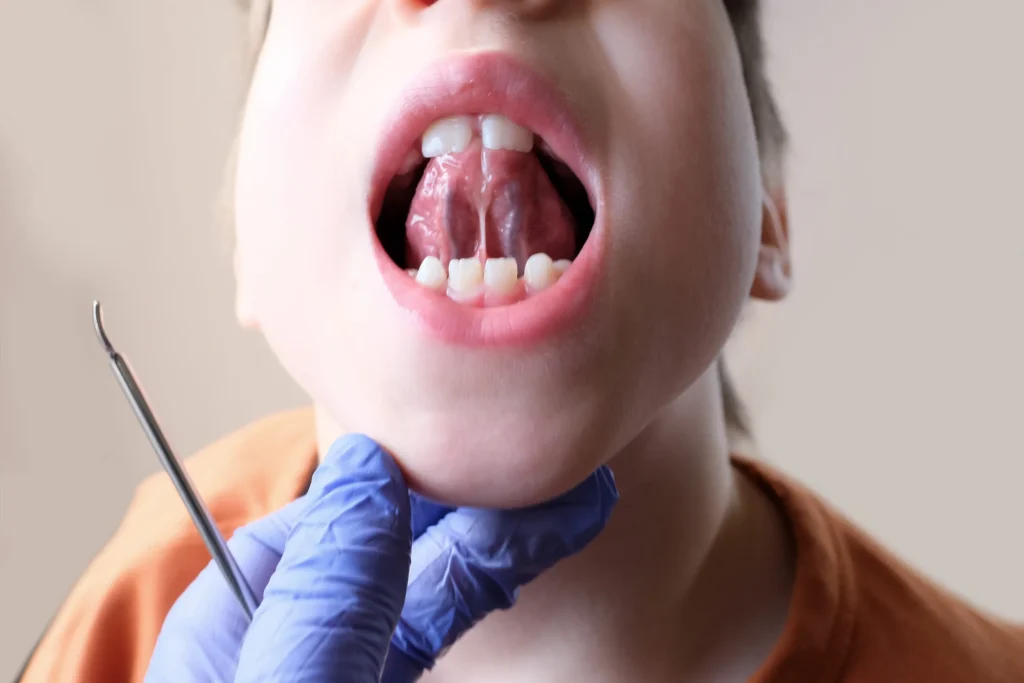Tongue-tie, or ankyloglossia, is a condition where the lingual frenulum (the band of tissue under the tongue) is too short, tight, or thick, restricting tongue movement. This condition can affect feeding, speech, and oral hygiene. A common concern is whether tongue-tie is hereditary. Research suggests that genetics and environmental factors both play a role. Let’s explore the connection, its implications, and available treatments.
What is Tongue-Tie?
Tongue-tie is a congenital condition that can lead to challenges such as:
- Difficulty breastfeeding in infants.
- Delayed or impaired speech development in children.
- Compromised oral hygiene and dental health in adults.
Understanding the hereditary nature of this condition helps families recognize it early and seek timely treatment.
Is Tongue-Tie Hereditary?
Genetic Links
Research strongly indicates a genetic component to tongue-tie. Studies show:
- X-Linked Inheritance: Tongue-tie may follow an X-linked inheritance pattern. Since males have only one X chromosome, they are more prone to X-linked conditions, which explains why tongue-tie is more common in boys.
- MTHFR Gene Mutation: Mutations in the MTHFR gene, associated with midline defects, are often linked to tongue-tie. This gene impacts amino acid processing and tissue development, contributing to tongue-tie, lip-tie, and other oral anomalies.
Did you know? Families with a history of tongue-tie may notice its recurrence across generations, highlighting its genetic predisposition.
Environmental Factors
While genetics play a major role, external influences during pregnancy can also contribute:
- Vitamin A Deficiency: A lack of Vitamin A during fetal development can lead to improper tissue formation, increasing the likelihood of tongue-tie.
- Maternal Health: Smoking, alcohol consumption, or certain medications during pregnancy may interfere with normal fetal development.
Addressing these risk factors during pregnancy can reduce the likelihood of tongue-tie in newborns.
Associated Conditions

Tongue-tie often coexists with other midline defects, such as:
- Lip-Tie: A similar condition where the upper lip is tethered to the gum, causing feeding challenges.
- Cheek-Tie: Less common, but can add to oral complications.
Families with a history of midline defects should watch for signs of tongue-tie in infants.
How to Identify Tongue-Tie
Symptoms in Infants:
- Difficulty latching or breastfeeding.
- Clicking sounds during feeding.
- Poor weight gain despite regular feeding.
Symptoms in Children:
- Delayed speech or difficulty articulating certain sounds.
- Frustration during eating or speaking.
Symptoms in Adults:
- Persistent speech issues.
- Difficulty maintaining oral hygiene due to restricted tongue movement.
Diagnosis and Treatment Options

Diagnosis
Healthcare providers assess tongue-tie by:
- Examining the lingual frenulum.
- Testing tongue movement and its impact on feeding or speech.
Treatment Options
- Monitoring:
- Mild cases without significant symptoms may require no immediate intervention.
- Frenotomy:
- A quick procedure where the frenulum is snipped to release the tongue. It is often performed without anesthesia for infants.
- Frenuloplasty:
- A surgical option for severe cases or thick frenula, often under local or general anesthesia. It may include sutures for precise repair.
- Speech Therapy:
- For older children or adults, therapy helps improve articulation and oral function post-surgery.
Implications for Families
If you or someone in your family has tongue-tie, understanding its hereditary nature can prepare you for early diagnosis and treatment. Early intervention, especially in infants, can:
- Improve breastfeeding success.
- Prevent speech delays.
- Enhance overall oral health.
Steps for Parents
If you suspect tongue-tie:
- Observe Symptoms: Watch for feeding, speech, or oral hygiene challenges.
- Consult a Specialist: Pediatricians, lactation consultants, or pediatric dentists can diagnose and guide treatment.
- Follow Up: Regularly monitor progress after treatment to ensure lasting benefits.
Conclusion
Tongue-tie is often hereditary but influenced by environmental factors. Early recognition and treatment can significantly improve quality of life, especially in infants and children. If you suspect tongue-tie in yourself or a loved one, consult a healthcare professional for guidance.
For more information and personalized consultation, contact your nearest specialist or visit our clinic. Don’t wait—take the first step towards better oral health today!
FAQs
Yes, genetic conditions like tongue-tie may skip generations depending on inheritance patterns and other influencing genes.
While genetics play a significant role, environmental factors during pregnancy also contribute.
Mild cases may improve as the child grows, but severe tongue-tie typically requires intervention.
Yes, adults can undergo frenuloplasty or speech therapy to address tongue-tie symptoms.


